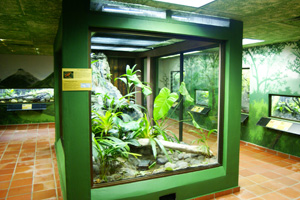In 2004, the Panamanian Golden Frog was garnering attention as a group of zoos, universities and researcher known as Project Golden Frog were responding to the ongoing decline and disappearance of this species in the wild while developing populations of captive golden frogs as a safeguard against extinction. One of their goals at the time was “our expectation that this species holds the potential to rally public support for amphibian conservation throughout the Neotropics”. At the same time, the chytrid fungus was winding its way through western Panama heading directly for the only known habitat of the Panamanian Golden Frog.
 It seemed like a simple idea at the time. Houston Zoo staff thought it was would be in the best interest of this species to build a small facility where we could house this species in its range country until we had a better idea of when amphibians in the region could safely be released back into the wild, safe from the chytrid fungus which has now moved through western Panama and is heading for the eastern side of the Panama Canal.
It seemed like a simple idea at the time. Houston Zoo staff thought it was would be in the best interest of this species to build a small facility where we could house this species in its range country until we had a better idea of when amphibians in the region could safely be released back into the wild, safe from the chytrid fungus which has now moved through western Panama and is heading for the eastern side of the Panama Canal.
But what about all the other amphibians in the region, surely they are in need of protection as well? From this one species, it was decided that a larger focus, based on the 15-20 species potentially threatened with extinction due to the chytrid fungus, should be protected within what was soon to become the El Valle Amphibian Conservation Center.
 EVACC center$250,000, 50 plus partners, 17 species and 600 individuals later – El Valle Amphibian Conservation Center in El Valle de Anton, Panama opened its doors to the public in May of 2009 and has been the focus of media attention, Animal Planet specials, and news articles over the past 2 years. It even has its own 15 minute documentary called Leap of Faith and Spanish version Un Salto de Fe. So now we wait for a cure and manage the individuals we have collected with support from the zoos, schools, corporations and private individuals.
EVACC center$250,000, 50 plus partners, 17 species and 600 individuals later – El Valle Amphibian Conservation Center in El Valle de Anton, Panama opened its doors to the public in May of 2009 and has been the focus of media attention, Animal Planet specials, and news articles over the past 2 years. It even has its own 15 minute documentary called Leap of Faith and Spanish version Un Salto de Fe. So now we wait for a cure and manage the individuals we have collected with support from the zoos, schools, corporations and private individuals.
Actually, we cannot wait. The fungus is jumping the Canal Zone and heading into the largest contiguous tract of rainforest not currently affected by the fungus – called the Darien Gap. We do not know how many species exist within the Darien Gap, undiscovered species that could disappear before we ever knew they had existed.
In 2008, the Houston Zoo and Zoo New England partnered on the design and development of an Amphibian Pod which is now housed at the Summit Municipal Parque. This pod is actually a shipping container based on models developed by groups in Australia and England and modified to maintain amphibians where each pod can safely house 1-2 species of individual amphibians; managing and reproducing them through their life history stages. This was simply the first phase of what you will see here on these pages in months to come. The Panama Amphibian Rescue and Conservation program has brought together partners for Eastern Panama while the El Valle Amphibian Conservation Center continues to focus on Western Panama. And hopefully together, these partners can hold the line against what seemed to be the imminent extinction of dozens of amphibians within Panama’s borders.
